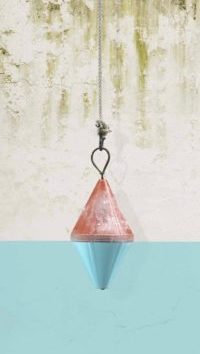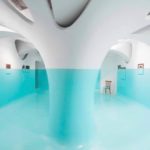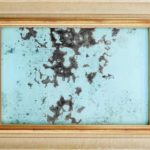
Everything began from a seed, of exploring time, its passing and the trans- formations that this implies in the outside world. This is the birth of the artist Davide D’Elia’s work, whom was born in 1973, with Salerno origins and his operation base between Rome and London. His works – organic tissues in which life exists – are “contaminated”, and vulnerable to constant change. We are talking about abandoned wallpapers that preserve the physical and emo- tional imprints of their past history, canvas painted by unpredictable mold and not “stormy” shaped, indelible traces created by water droplets of faulty valves, water marks instilled on canvassed supports and not. The phenomena of nature and their interaction with matter thus become creative expression of a meticulous scientific re- search that has come recently to further evolution. One of the central elements of his studio has become the antifouling paint, a paint used to protect boats, which inhibits the proliferation of algae, corals and mold on the hulls. D’Elia installs his paint on the walls of the room, his blue iris invades part of the furniture, cuts in half the old hanged paintings and everything he cross in his path defined by its inexorable geometries. The intent is to create the contrast between an aseptic environment, refractory to life, and an healthy and vital one. Doing this way the artist intends to strengthen the dialectical opposition between life and its absence, between hot and cold, formal and informal. These opposites describe and represent the world and its conflicts.
The antifouling welcomed Italians athletes at the recent Olympic Games in Rio De Janeiro through Horiz-ontal, site-specific work installed at Casa Italy, the Olympic village that hosted the Italian athletes at Club Costa Brava.
The characteristic feature of the last works by D’Elia is also the focus for the sub- merged, the flotation of bodies and the duality in the perception of heat and cold. The aquatic imagery has inspired various works through the use of floating bodies such as buoys, submerged and floating between the underwater world and not, between what is above and below the surface. The theme has resulted recently in a performa- tive project at Maxxi of Rome entitled Crossover in which the French artist Renaud Au- guste-Dormeuil has asked ten Italian non performative artists to answer the question “If a work of art can be performed?”. D’Elia responded with Amphibious, a work in which the artist puts on stage a synchronized swimming team that performs the learn- ing exercises of aquatic choreography. In this way he theatricalize the submerged part of the choreography and finally makes it visible. As the artist himself says, “we expect that the viewer feels as in the belly of a submarine that sails around an iceberg, only vaguely reminiscent of the glitter of ice on the surface.” A little as contemporary art it is perceived, frivolous and lacking of a persistent and painstaking work, but actually it hides a complex underwater world.
More info: http://davidedelia.com
Cover: Davide D’Elia, FLO (2014), Art is Real G-rough, Roma, billboard, Site specific installation, 8×20 m
 English
English  Italiano
Italiano 





